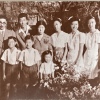Japanese international minister Namoru Shigemitsu indicators give up phrases as Allied officers look on Sept. 2, 1945 on USS Missouri moored in Tokyo Bay.
HUM Photographs/Getty Photographs
conceal caption
toggle caption
HUM Photographs/Getty Photographs
It was — fairly presumably — the worst day to make a mistake.
Sept. 2, 1945 was the day Japan formally surrendered to the Allies. It marked the official finish of World Struggle II.
The ceremony occurred on the deck of an American battleship, the usS. Missouri, moored in Tokyo Bay. Tons of of individuals crowded the deck to observe or take part within the momentous event.
Among the many signatories despatched by every of the main Allied powers was a comparatively low-ranking Canadian: Col. Lawrence Cosgrave, Canada’s protection attaché to Australia on the time.
Cosgrave was the very best rating Canadian army officer who may get to the ceremony in time, says Murray Brewster, a protection and international coverage correspondent for the Canadian Broadcasting Company.

“I am fairly positive that he was in awe of standing amongst so many high-ranking officers. I imply, ones whose names go down in historical past,” Brewster just lately instructed NPR.
As soon as the Japanese delegation boarded the Missouri, the proceedings started. The 2 teams of signatories stood on reverse sides of a desk introduced from the battleship’s mess corridor. On the desk had been two copies of the instrument of give up: one for the Japanese and one for the Allies.
As soon as the Japanese representatives signed, it was time for the Allies to do the identical.
The method went easily till it got here time for Cosgrave to signal. When he sat right down to put pen to paper, Cosgrave ended up signing his title on the incorrect line.

United States Military Gen. Douglas MacArthur reads his speech to open the give up ceremonies on board USS Missouri on Sept. 2, 1945. Allied representatives are behind him, together with Col. Lawrence Cosgrave.
U.S. Navy, Public area, through Wikimedia Commons
conceal caption
toggle caption
U.S. Navy, Public area, through Wikimedia Commons
“It had the potential at that second of making a little bit of a diplomatic incident, as a result of the Japanese, once they noticed that not the entire signatures had been within the applicable place, prompt to Normal MacArthur’s chief of employees that they would not settle for the doc,” Brewster mentioned.
However the second handed. Somebody got here up with a repair and the Japanese ultimately relented.
The injury to Cosgrave’s legacy, although, was finished.
The New York Instances famous Cosgrave’s loss of life in 1970 by writing that he “unintentionally delayed the conclusion of the armistice.”
That Cosgrave was remembered largely for his mistake did not appear proper to Brewster. He poured by the data that remained of Cosgrave’s life on the Canadian Struggle Museum and first wrote about his findings for Legion Journal.
Cosgrave was a veteran of World Struggle I and had misplaced an eye fixed a few years earlier than the give up ceremony.
“He went into the primary World Struggle all stuffed with patriotic zeal and the slaughter that he witnessed in a few of the main battles that occurred … deeply traumatized him and deeply affected him,” Brewster mentioned.

After the struggle, he served as a diplomat in East Asia. He traveled extensively in Tokyo and different Japanese cities throughout that point — cities he would later return to in 1945.
“Yokohama is the town of the useless, the dreadful impact of recent firebombing fusing glass, iron and home goods into full nothingness,” Cosgrave wrote to a buddy across the time of the give up after witnessing the results of Allied firebombing, based on Brewster.
Brewster says that Cosgrave was “in all probability overwhelmed … on the time of the signing due to the corporate he was in.” He was surrounded by officers made well-known by years of struggle.
Cosgrave’s story additionally comes with a lesson: do not be so fast to guage, Brewster says.
“We reside in an age proper now the place there are instantaneous judgments about individuals and about their character,” he says. “(Cosgrave is) identified to historical past as the person who signed on the incorrect line. However his life was a lot greater than that.”









